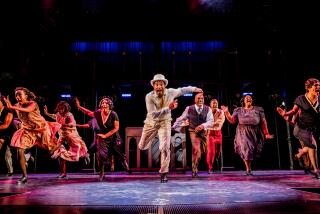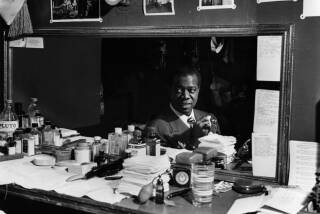Tales of the Jazz Age
- Share via
Richard Bruce NUGENT’S novel “Gentleman Jigger” is a strange cocktail of glamour and dirt that goes down easy, quickly intoxicates and leaves a pungent taste. It may just give you a hangover. But anyone who has ever lamented that he or she was born too late to spend an evening at Georgia Douglas Johnson’s legendary Washington, D.C., salon frequented by black writers, artists and politicians, or to spend any hour at 267 W. 136th St. “when Harlem was in vogue,” should rush to risk the head pounding.
Cracking “Gentleman Jigger,” however, is a bit like opening a door to a party full of very interesting, sometimes dangerous, sometimes dazzling people who all know one another -- but don’t know, and perhaps don’t want to know, you. The experience is also akin to sitting beside a bold-living, wild-loving, deliciously indiscreet man of fine lineage willing to regale you with juicy gossip from the world of art and letters and tender but explicit favored incidents in his sexual history, all the while reeling off the names of dozens of books you might want to poke into and why, and pausing to provide a primer of social etiquette among certain elements of black bohemia before tutoring you on how to capture the un-capturable man.
Allow me to make a few introductions. Richard Bruce Nugent was born in Washington, D.C., to a prominent black family in 1906. At one of Johnson’s “Saturday Nighters,” Nugent met Langston Hughes, who eventually introduced him to Wallace Thurman, the dark-skinned genius who penned “The Blacker the Berry” (1929), a novel that explores color biases within the African American community.
Shortly after Nugent moved to New York, he and Thurman (who would die at 32, laid low by alcohol and finished off by tuberculosis) became roommates. Both were black, both were gay, both went on to write novels centered on the denizens of the building on West 136th Street, referred to by Harlem Renaissancers as Niggerati Manor. Thurman’s “Infants of the Spring” was published in 1932. Nugent’s novel, “Gentleman Jigger,” probably written between 1928 and 1933, has only now seen publication -- 21 years after his death.
Thurman appears here as Henry Raymond Pelman: “So black! So handsome! So small and so brilliant!” Nugent appears in “Infants” as Paul Arbian -- an artist who creates “highly colored phalli.” “Infants” ends with Paul’s suicide. Nugent has the last laugh. “Gentleman Jigger” is by far the superior work.
The book begins in D.C., parsing the genealogy of the protagonist, Stuartt, who enjoys a socially privileged and economically precarious existence -- very much like Nugent’s own. Young Stuartt recites Paul Laurence Dunbar’s “Little Brown Baby” on demand but prefers to gorge himself on Nick Carter and Rabelais. The pale but black boy has a particular fondness for “Gargantua” and “The Decameron” and a peculiar loathing of dark-skinned people. “He could not bear the thought of having to face Miss Hussey every day . . . . For Miss Hussey was black, and Stuartt was prejudiced in the extreme. . . . He had never been allowed to play with dark children.”
When it is discovered that instead of selling newspapers -- to help fill the family coffers -- Stuartt is robbing his piggybank, the school-age boy “took his thrashing, said he was ashamed, promised to really sell his papers in the future, and retired to dry his tears and meditate upon his sin in solitude like a little man. He took the volume of Boccaccio to the toilet with him.” Stuartt is an odd and interesting boy who becomes a bold and more interesting man.
As Stuartt zigs and zags across the color line, the plot zigs and zags across a wide swath of America -- from black Washington to Mormon Utah, arriving in Harlem, heading off West again -- to gangster Chicago before bouncing back to Gotham by way of a Hollywood-on-the-East River version of Astoria, Queens.
It is in the Harlem sections that “Jigger” recalls Claude McKay’s “Home to Harlem” (1928), Carl Van Vechten’s “Nigger Heaven” (1926) and the comparatively staid and scolding “Infants.” What elevates Nugent’s effort is his ability to construct a character, Stuartt, who moves through a series of erotic adventures and love affairs to bloom into a gorgeous original: writer and painter, hyper-intellectual and hyper-sexual, friend of black intellectuals, lover of Italian gangsters, fiance of Lake Shore Drive debutante, rising star of stage and film, dance partner of gangster moll, brother of brilliant poet (white), brother of brilliant dancer (black), son of elegant mother content to allow her sons to pass beyond her reach if they place themselves high -- as unforgettable as he is improbable.
Ultimately the best comparisons may be Fitzgerald’s “The Great Gatsby” (1925), Nella Larsen’s “Passing” (1929) and Andre Gide’s “The Immoralist” (1902) and “The Counterfeiters” (1926). Tramping in from the Hamptons to Harlem, “Gentleman Jigger” expands our understanding of the Jazz Age by exploring the sexual attraction of gangsters and the eroticism of dirty money. And the humiliation, vulnerability and alienation inherent in masking one’s identity in “Passing” takes on new resonance when juxtaposed here with the exuberance of stripping and the confident performance of nakedness. Placing his book alongside the Gide, we appreciate first Nugent’s idiosyncratic constructions and meta-text references but arrive at an awareness that Gide, though he gives much insight into why some white men desire some dark men, left much unsaid about why some dark men desire white men exclusively. Nugent has much to say on that subject.
The climax of “Gentleman Jigger” occurs in a swank nightclub. Somewhere Prince Orloff is chatting about something; somewhere else someone else is talking about the Scottsboro boys. A Chicago gangster/former lover of Stuartt’s is at one table. A New York gangster/former lover of Stuartt’s is at another. Jungle chorus numbers thrill as the show moves toward the star attraction. In the midst of all this, Stuartt is outed as black. The night is half-saved when the dancer Rhythm, the star of the headlining Sepia Steppers, announces that Stuartt is his brother.
Accompanied by his brother, mother, gang boss-lovers, bodyguards and dance partner, Stuartt leads a proud and peculiar parade out of the club. The next day Stuartt makes his studio bosses, still stunned by the apparent transformation of their Fred Astaire into Bojangles, pay him more not to be in the movies than they were going to pay him to be in them. And so the novel that begins with a little boy taking money for services he did not provide ends with a story of a man receiving money for services he will not provide.
Gossipy, irreverent, partisan, indiscreet, exaggerated, erudite, perhaps borrowed, perhaps pillaged (in “Jigger,” Stuartt and Raymond are both writing novels; but it is Raymond, the Thurman character, who steals scenes and lines from Stuartt, the Nugent character), at times frustratingly obscure -- “Gentleman Jigger” is also shamelessly erotic, helpfully romantic, presciently modern in its contemplation of the cult of celebrity and largely autobiographical.
Passing on the up-high is far more complicated than just passing, or passing on the down-low. Pretending to be white while pretending to be straight is tricky business. “Gentleman Jigger” knows all the tricks. Nugent reveals them with zeal.
More to Read
Sign up for our Book Club newsletter
Get the latest news, events and more from the Los Angeles Times Book Club, and help us get L.A. reading and talking.
You may occasionally receive promotional content from the Los Angeles Times.








